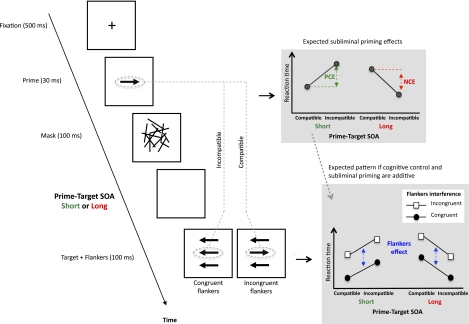Fig. 1.
Schematic illustration of the task, which combines subliminal priming and flanker interference. If the stimulus onset asynchrony (SOA) between prime and target (response) cue is short (70 ms), a PCE in response times is found (green). If the SOA is longer (180 ms), an NCE is found (red). Compatibility refers to whether the direction of prime arrow and target (response) arrow is the same (compatible) or different (incompatible). Targets are flanked by arrows. If the flankers are congruent with the target, then response times are shorter than if flankers are incongruent (the flanker interference effect; blue plot). The question is whether these effects interact. The stimuli represent the ones used in most experiments, but they are schematic. The sequence illustrated is that for the long SOA condition. In the short SOA condition, there was no blank screen between mask and target, and the mask (always 100 ms in duration) was still on the screen when the target-flanker set appeared (Fig. S1). For this reason, in both conditions, the target-flanker set was actually presented at a random position in a virtual annulus around the mask locus (Fig. S1).

